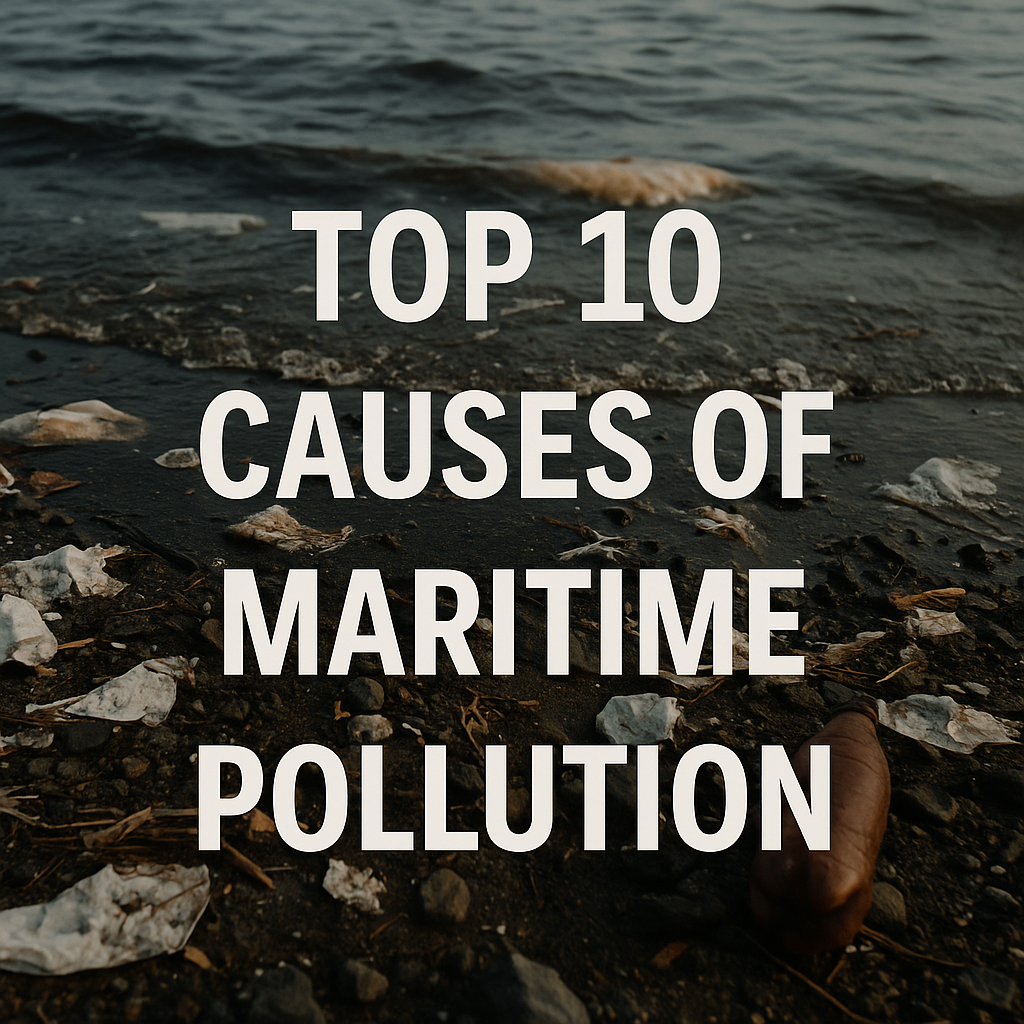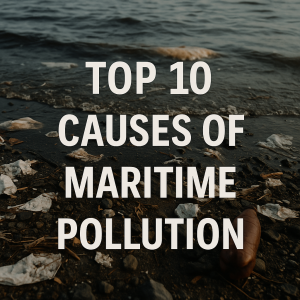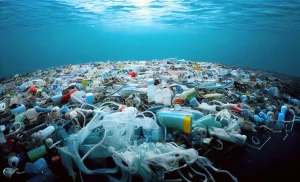Discover the top 10 causes of maritime pollution and how they impact oceans, marine life, and global trade. Learn about the environmental risks, regulatory responses, and the future of sustainable shipping.
Why Maritime Pollution Matters in Modern Shipping
The ocean is not only the lifeblood of global trade—carrying over 80% of the world’s goods—but also one of the planet’s most delicate ecosystems. Yet, as the maritime industry expands to meet growing demand, the environmental cost of shipping has come under sharp scrutiny.
Maritime pollution threatens biodiversity, human health, fisheries, and climate stability. From oil spills and ballast water discharge to air emissions and plastic waste, the industry’s footprint stretches far beyond the visible horizon.
As regulatory pressure tightens and global awareness grows, maritime professionals must understand what causes ocean pollution, where responsibilities lie, and how to take part in cleaner, compliant operations. This guide explores the top 10 causes of maritime pollution, supported by case studies, recent statistics, and actionable insights.
1. Oil Spills and Bilge Water Discharges
Oil pollution is among the most visible and devastating forms of maritime contamination. Large-scale tanker accidents like the Exxon Valdez (1989) or MV Wakashio (2020) release thousands of tons of crude oil, causing long-term ecological damage.
However, routine bilge water discharges—if improperly treated—pose a silent threat. These discharges often contain oil residues and other hazardous substances.
Regulation: MARPOL Annex I strictly prohibits the discharge of oily water unless it passes through an operational Oily Water Separator and is below 15 ppm oil content.
Stat: According to the IMO, illegal bilge dumping accounts for a significant portion of oil detected in satellite marine surveillance efforts globally.
2. Ballast Water Discharge
To maintain stability, ships intake ballast water in one port and release it in another. This process can introduce invasive marine species to new ecosystems, often with irreversible consequences.
Case Study: The invasive zebra mussel in the Great Lakes of North America is believed to have arrived via ballast discharge from European ships, causing millions in economic damage.
Solution: The Ballast Water Management Convention (BWMC) mandates onboard treatment systems or exchange procedures before discharge.
3. Air Pollution from Ship Emissions
Modern ships burn heavy fuel oil (HFO), a high-sulfur residual product that contributes significantly to air pollution. These emissions include:
-
SOx (sulfur oxides)
-
NOx (nitrogen oxides)
-
Particulate matter (PM)
-
Carbon dioxide (CO₂)
Regulation: Under MARPOL Annex VI, the IMO introduced a global sulfur cap of 0.50% in 2020, and 0.10% in Emission Control Areas (ECAs).
Stat: Shipping contributes around 2.89% of global CO₂ emissions, per the Fourth IMO GHG Study (2020).
4. Marine Plastic Waste
While land-based sources account for most marine plastic, ship-generated plastic waste—especially from fishing vessels and cargo ships—still plays a damaging role.
Common Offenders:
-
Lost or discarded fishing gear (ghost nets)
-
Food wrappers, plastic bags, and packaging
-
Illegal dumping overboard
Regulation: MARPOL Annex V strictly prohibits plastic discharge. Ships must maintain a Garbage Management Plan and Garbage Record Book.
Example: In 2018, a major cruise line was fined $40 million for intentionally dumping plastic-laden waste into the ocean and falsifying records.
5. Chemical Pollution (Noxious Liquid Substances)
Chemical tankers carry noxious liquid substances (NLS) such as pesticides, solvents, and industrial chemicals. Improper cleaning of tanks or illegal discharge of cargo residues leads to significant marine contamination.
Precaution: Cargoes are categorized into X, Y, Z, or OS based on hazard levels, with mandatory pre-wash procedures and discharge monitoring.
6. Anti-Fouling Paints and Coatings
Ships use antifouling paints to prevent the accumulation of marine organisms on hulls. Many older formulations contained tributyltin (TBT), a biocide known to cause deformities in marine life.
Regulatory Response: The IMO’s AFS Convention banned TBT in 2008. New-generation coatings use copper or silicone-based alternatives, but concerns remain over biocide leaching into marine ecosystems.
7. Sewage Discharge
Ships generate sewage (black water) from toilets and medical facilities. If untreated, this waste can cause oxygen depletion, promote algal blooms, and spread pathogens.
Regulation: MARPOL Annex IV prohibits untreated sewage discharge within 12 nautical miles from shore. Modern ships use sewage treatment plants (STPs) or holding tanks.
8. Underwater Noise Pollution
The constant hum of ship engines and propellers generates underwater noise that can disturb marine mammals like whales and dolphins.
Effects:
-
Disruption of migratory and mating patterns
-
Increased stress and disorientation
-
Interference with sonar navigation
Recent Developments: IMO is considering guidelines for quiet ship design, especially in sensitive regions like the Arctic.
9. Operational Accidents and Groundings
Not all pollution is intentional or procedural. Accidents—such as groundings, collisions, or engine room fires—can lead to sudden, large-scale discharge of oil, cargo, or hazardous materials.
Example: The 2021 grounding of the MV Ever Given in the Suez Canal raised concerns over potential fuel leakage, although major spillage was averted.
Mitigation: Emergency plans (e.g., SOPEP, SMPEP) and fast crew response are critical.
10. Port and Bunkering Operations
Pollution can also occur during routine port operations, including:
-
Bunkering (fuel transfer)
-
Ballast exchange
-
Cargo loading/unloading
-
Maintenance activities
Risks:
-
Oil spills during hose disconnection
-
VOC emissions from cargo tanks
-
Paint and solvent runoff during maintenance
Control Measures: ISPS, port reception facilities, and stringent port state control (PSC) inspections.
Real-World Application: The Cost of Negligence
In 2022, a bulk carrier was fined €800,000 by Spanish authorities after an aerial patrol detected oil slicks trailing from the vessel. Upon investigation, crew had bypassed the Oily Water Separator (OWS) and falsified Oil Record Book entries. The company faced regulatory penalties, insurance hikes, and reputational loss.
FAQ: Causes and Consequences of Maritime Pollution
Q1: What is the biggest cause of marine pollution from ships?
A: Historically, oil pollution has been the most visible, but ballast water and air emissions are now leading environmental concerns due to their scale and global reach.
Q2: Can plastic be legally discharged from a ship?
A: No. Under MARPOL Annex V, all forms of plastic discharge are prohibited in all sea areas.
Q3: Are new ships cleaner than older ones?
A: Generally, yes. Newer ships are built with better fuel systems, exhaust scrubbers, ballast treatment units, and noise-reduction technologies.
Q4: What happens if a ship violates pollution regulations?
A: Detention, heavy fines, loss of port access, and possible criminal prosecution under national and international laws.
Q5: How can seafarers help reduce pollution?
A: Through proper equipment use, accurate recordkeeping, reporting leaks or violations, and participating in training and environmental drills.
Conclusion
The ocean is both a highway and a habitat. The maritime industry cannot thrive at the expense of the environment. Understanding the top 10 causes of maritime pollution helps seafarers, shipowners, and regulators align their efforts toward cleaner seas.
Prevention is always more effective—and affordable—than cleanup. By integrating sound engineering, updated regulations, and everyday vigilance, the industry can move toward a truly sustainable shipping model.
Call to Action: Explore best practices, compliance checklists, and MARPOL updates at our Marine Environmental Compliance Hub.
References
-
International Maritime Organization. (2020). MARPOL and Environmental Regulations. https://www.imo.org
-
European Maritime Safety Agency. (2022). Annual Overview of Marine Casualties. https://emsa.europa.eu
-
IMO GHG Study. (2020). Fourth IMO Greenhouse Gas Study. https://www.imo.org/en/OurWork/Environment/Pages/GHG-Emissions.aspx
-
Ocean Conservancy. (2023). Plastics and the Ocean Crisis. https://oceanconservancy.org
-
International Chamber of Shipping. (2021). Guidance on Ship Air Emissions. https://www.ics-shipping.org




I simply wished to appreciate you again. I’m not certain the things that I might have tried without the actual aspects provided by you directly on such a industry. Entirely was a real difficult issue in my circumstances, but taking a look at a specialised strategy you processed that forced me to cry over delight. Now i’m happy for the support and even wish you realize what a great job your are getting into training most people with the aid of your webpage. Most probably you have never come across all of us.
Hi, for all time i used to check blog posts here early in the morning,
for the reason that i love to find out more and more.